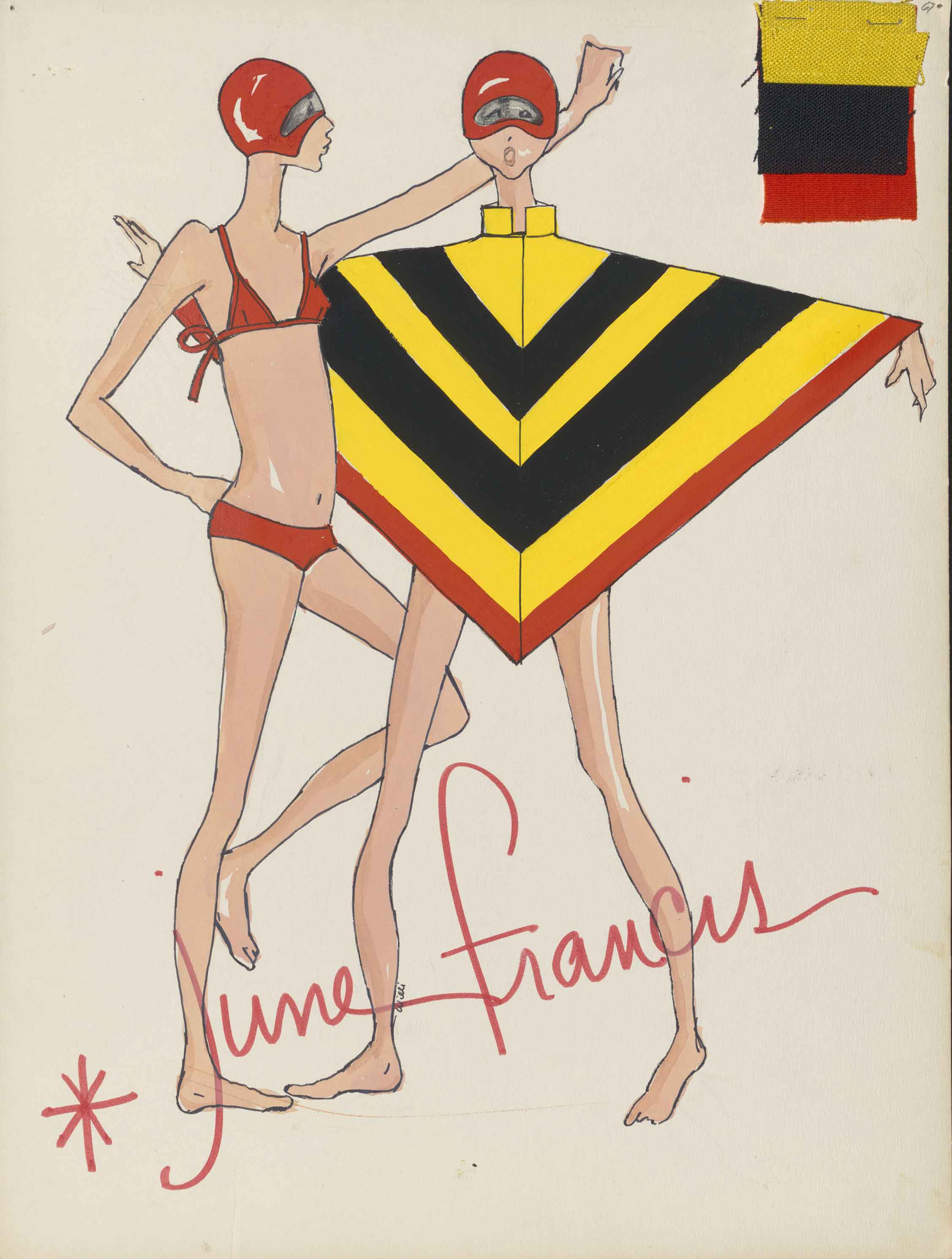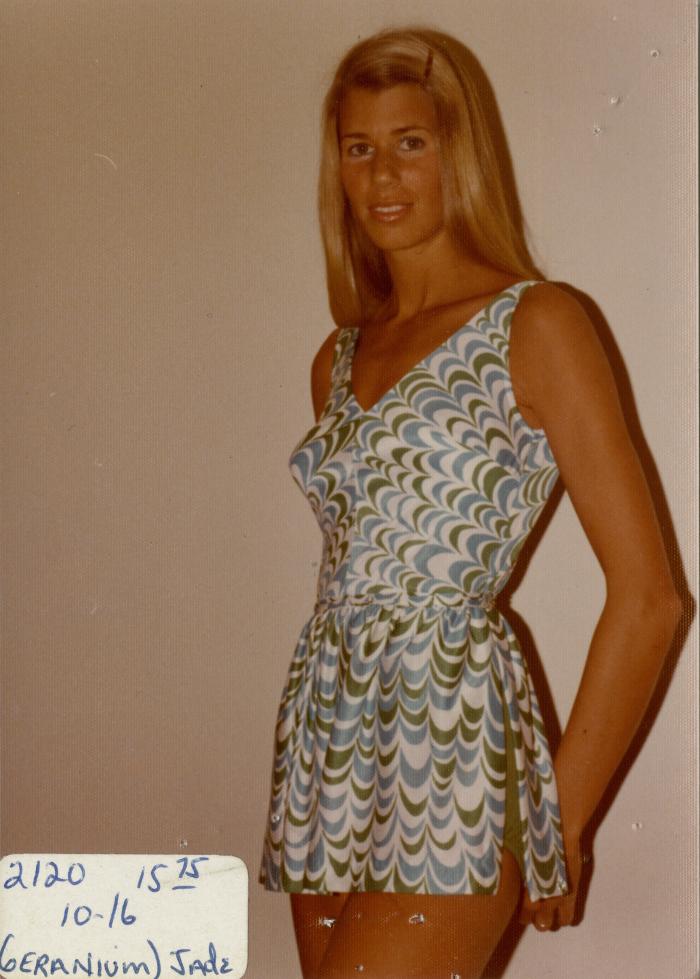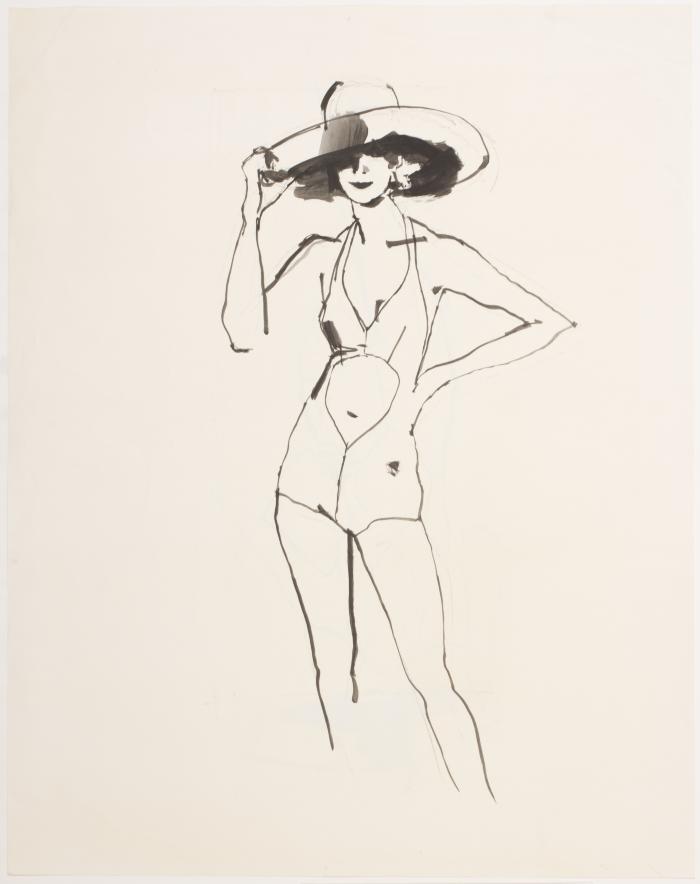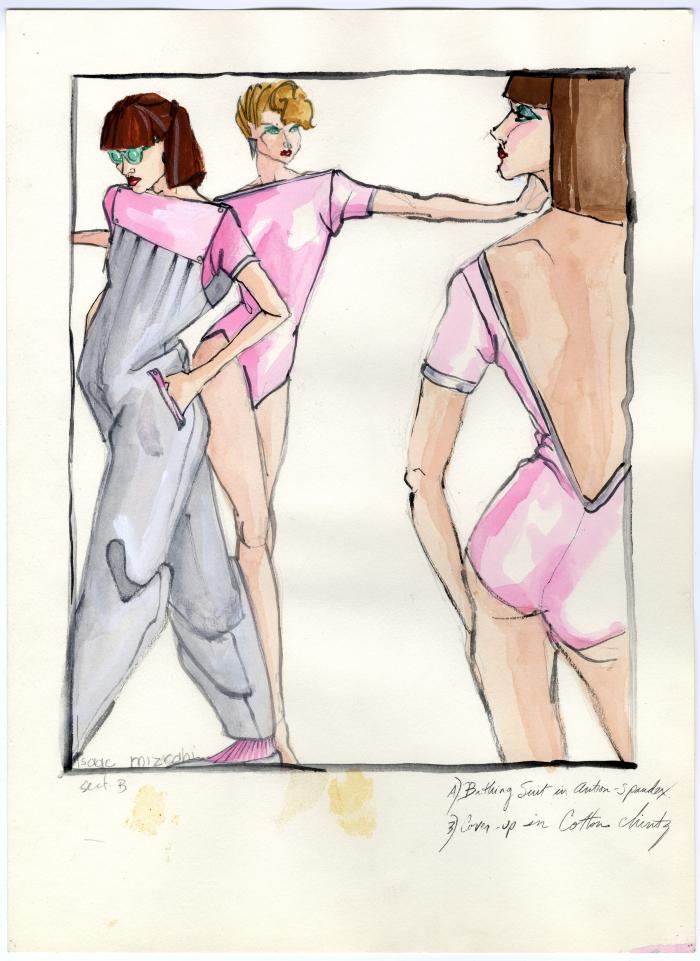by Sara Idacavage
This is the second part of our series on the history of women’s swimwear. Click here to view Part 1!
At the end of our previous post, we took a look at a relatively modest beach ensemble from 1959. Judging by the image below, quite a bit changed over the following decade!

Part of the Fashion Design Department Records, the teeny-tiny bikini and beach poncho above were designed by Parsons student Robert Carreon and illustrated by his fellow classmate (and famed designer) Willi Smith. By the time this little number was presented at the 1967 annual Parsons School of Design fashion show, the bikini had become widely accepted in the United States, which was due in-part to cultural factors such as the growing influence of the youth market. There were also profound shifts in the perception of traditional sexuality throughout the Western world, especially as ‘the pill’ became increasingly accessible. This sexual revolution manifested itself in women’s fashion, shown through shorter skirts and barely-there triangle bikini tops like the one above. In 1964, designer Rudi Gernreich took the bikini one step further by introducing his infamous “monokini”, which fully exposed the wearer’s breasts. As Alexander Joseph observed in Vestoj,“the design was a succès de scandale, inspiring some 20,000 press articles in response.” Not surprisingly, the controversial swimsuit style didn’t sell very well, but it did make a social statement and marked a significant change in the swimwear industry. Additionally, the first swimsuit issue of Sports Illustrated debuted in 1964, making beach fashion more sexually appealing than ever before. (Of course, none of this would have been possible without the advent of spandex in the late 1950s, which decreased the need for heavy linings and supportive layers- hallelujah!)

Although the patterned swimsuit above looks conservative in comparison to Carreon’s red string bikini, the two ensembles were designed around the same time. This blue and green patterned suit was created by fashion designer Tom Brigance, who graduated in 1934 from the New York School of Fine and Applied Art (later Parsons School of Design). He made a name for himself by designing sportswear and beachwear for Lord & Taylor, inspiring a Vogue advertisement in 1939 that urged consumers to visit the store’s Beach Shop, “home of creations by Brigance, one of our own designers, whose ideas enchant even the blasé Riviera.” After serving in the Second World War, Brigance left the store to start his own firm and freelanced for Sportsmarket, Sinclair, and Gabar throughout the 1950s and 1960s. This image of a tanned blond in one of his signature looks is part of his collection of publicity materials and sketches, which is currently housed in The New School Archives and Special Collections.

Instead of shaping the body as women’s swimsuits did in the 1940s and 1950s, swimwear in the 1970s was intended to show off the tan and sculpted bodies underneath, which had become the new ideal. The image above is from the collection of Fred Greenhill, which is chock-full of beautiful illustrations (some of which are now available online for your viewing pleasure). Greenhill graduated from Parsons School of Design in 1950 and spent his career working as a fashion illustrator for department stores such as Lord & Taylor, Neiman Marcus, and Saks Fifth Avenue. The one-piece swimsuit above (presumably made for a department store advertisement) features a large cut-out on the torso to display the wearer’s toned stomach. Although most one-piece swimsuits covered more skin than bikinis, it was very popular to include designs that emphasized certain erogenous zones. Take, for example, Farrah Fawcett’s iconic red swimsuit from 1976, which was immortalized in the form of a poster that hung in millions of teenage boys’ bedrooms across the country. As this poster easily proves, one-piece swimsuits could still be considered quite racy!

Our series concludes with this illustration by a young Isaac Mizrahi, which is also part of the Fashion Design Department records. Mizrahi’s sleek designs are emblematic of the fitness craze that impacted fashion throughout the 1980s, showing a strong influence from Olympic swimmers’ and gymnasts’ uniforms. Although the front of the swimsuit covers the entirety of the wearer’s chest, the plunging back still makes the look very provocative. The loose cover-up also represents the voluminous garments that many associate with 1980s fashion. Looking at the illustration, it’s almost difficult to know whether the wearer is heading to the beach or a jazzercise class. In any case, athleticism was an important consideration for fashion designers at the time, and these garments certainly reflect that.
Throughout this series, we’ve looked at bloomers, bikinis, and everything in-between. We hope that you’ve learned something about the cultural significance of women’s swimwear, as well as the diversity of materials that can be found at The New School Archives and Special Collections.
List of Figures:
Fig. 1: Robert Carreon. Red Bikini and Striped Linen Triangle. 1967. Fashion Design Department records (pre-2008 accessions). New School Archives and Special Collections Digital Archive. Web. 08 Jul 2015. https://digital.archives.newschool.edu/index.php/Detail/objects/PC02020…
Fig. 2: Tom Brigance. Model in Blue, Green and White Skirted V-neck Swimsuit. . Tom Brigance publicity and sketches. New School Archives and Special Collections Digital Archive. Web. 08 Jul 2015. https://digital.archives.newschool.edu/index.php/Detail/objects/KA0005_…
Fig. 3: Fred Greenhill. Swimsuit with Cut-Out Center. 1970s. Fred Greenhill fashion illustrations. New School Archives and Special Collections Digital Archive. Web. 08 Jul 2015. https://digital.archives.newschool.edu/index.php/Detail/objects/KA00220…
Fig. 4: Isaac Mizrahi. Pink Spandex Bathing Suit with Cotton Chintz Cover-Up. 1982.Fashion Design Department records (pre-2008 accessions). New School Archives and Special Collections Digital Archive. Web. 08 Jul 2015. https://digital.archives.newschool.edu/index.php/Detail/objects/PIC0200…